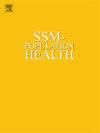Immigration, acculturation, and diabetes: A comparative study of diabetes prevalence among Asian Indian immigrants living in the United States and native-born populations in India and the United States
IF 3.1
2区 医学
Q1 PUBLIC, ENVIRONMENTAL & OCCUPATIONAL HEALTH
引用次数: 0
Abstract
Despite evidence that Indian immigrants in high-income countries have higher diabetes risk, few studies have directly compared Indian immigrants to both Indians in India and the general population. We compared diabetes prevalence in the Mediators of Atherosclerosis in South Asians Living in America (MASALA) study (Indian immigrants) (N = 686), the Longitudinal Aging Study in India (LASI) (Indians in India) (N = 40,496), and the Health and Retirement Study (HRS) (general US population) (N = 7643), accounting for selective immigration using propensity score matching. We used generalized regression models to assess associations between diabetes and acculturation in MASALA and compare correlates of diabetes across studies. After matching, Indians in India had a higher prevalence of diabetes (37.9 % [35.4–40.5]) than Indian immigrants in the US (26.7 % [23.5–30.1]) and the general US population (19.6 % [17.6–21.8]). Higher acculturation was associated with a lower diabetes prevalence (prevalence ratio [PR]: 0.68 [0.45–1.04], P = 0.078) and lower HbA1c (difference: 0.205 % [-0.408 to −0.001], P = 0.049). We also identified differences in the magnitude of correlations between diabetes and risk factors, including abdominal obesity (MASALA PR: 1.41 [1.09–1.81], LASI PR: 2.41 [2.29–2.54], HRS PR: 2.52 [2.17–2.93]). Cultural factors, including differences in lifestyle and diet, may play an important role in the high diabetes risk among Indian immigrants and explaining racial disparities in diabetes burden in the US.
移民、文化适应和糖尿病:生活在美国的亚洲印度移民与印度和美国本土出生人口中糖尿病患病率的比较研究
尽管有证据表明高收入国家的印度移民患糖尿病的风险更高,但很少有研究直接将印度移民与在印度的印度人和一般人群进行比较。我们比较了生活在美国的南亚人(MASALA)研究(印度移民)(N = 686)、印度纵向老龄化研究(LASI)(印度印度人)(N = 40,496)和健康与退休研究(HRS)(一般美国人口)(N = 7643)中动脉粥样硬化中介的糖尿病患病率,使用倾向得分匹配来解释选择性移民。我们使用广义回归模型来评估糖尿病和MASALA文化适应之间的关系,并比较研究中糖尿病的相关因素。经配对后,印度印度人的糖尿病患病率(37.9%[35.4-40.5])高于美国印度移民(26.7%[23.5-30.1])和美国普通人群(19.6%[17.6-21.8])。较高的文化适应与较低的糖尿病患病率(患病率比[PR]: 0.68 [0.45-1.04], P = 0.078)和较低的糖化血红蛋白(差异:0.205%[-0.408至- 0.001],P = 0.049)相关。我们还发现了糖尿病与腹部肥胖等危险因素之间相关性的差异(MASALA PR: 1.41 [1.09-1.81], LASI PR: 2.41 [2.29-2.54], HRS PR: 2.52[2.17-2.93])。文化因素,包括生活方式和饮食的差异,可能在印度移民的高糖尿病风险中发挥重要作用,并解释了美国糖尿病负担的种族差异。
本文章由计算机程序翻译,如有差异,请以英文原文为准。
求助全文
约1分钟内获得全文
求助全文
来源期刊

Ssm-Population Health
PUBLIC, ENVIRONMENTAL & OCCUPATIONAL HEALTH-
CiteScore
6.50
自引率
2.10%
发文量
298
审稿时长
101 days
期刊介绍:
SSM - Population Health. The new online only, open access, peer reviewed journal in all areas relating Social Science research to population health. SSM - Population Health shares the same Editors-in Chief and general approach to manuscripts as its sister journal, Social Science & Medicine. The journal takes a broad approach to the field especially welcoming interdisciplinary papers from across the Social Sciences and allied areas. SSM - Population Health offers an alternative outlet for work which might not be considered, or is classed as ''out of scope'' elsewhere, and prioritizes fast peer review and publication to the benefit of authors and readers. The journal welcomes all types of paper from traditional primary research articles, replication studies, short communications, methodological studies, instrument validation, opinion pieces, literature reviews, etc. SSM - Population Health also offers the opportunity to publish special issues or sections to reflect current interest and research in topical or developing areas. The journal fully supports authors wanting to present their research in an innovative fashion though the use of multimedia formats.
 求助内容:
求助内容: 应助结果提醒方式:
应助结果提醒方式:


